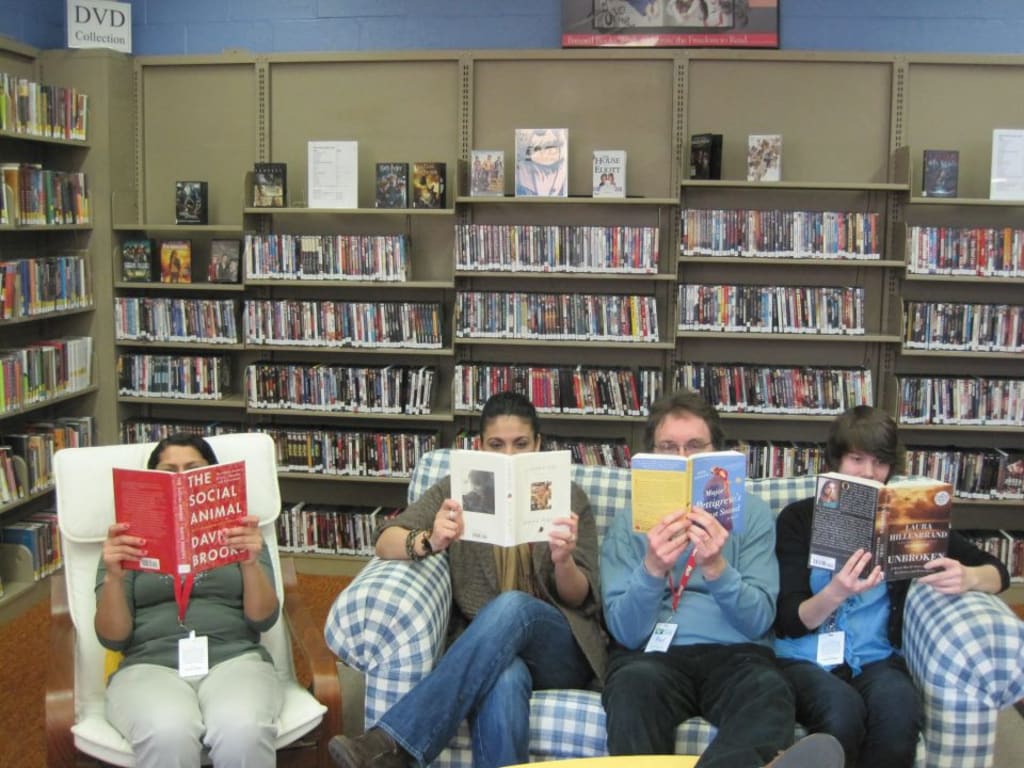10 Ways Your Local Library Saves You Money
Public libraries bear the stereotype of being out of date and inconsequential in today’s world. That thought couldn’t be more wrong; libraries provide an incredible public service for children and adults that enable them to grow and learn, as well as save money!

1. Free Books
Bibliophiles are familiar with the thrill that occurs when they trace their fingers over the cover of a new book they just bought. Opening it, they can actually smell the hot ash fluttering up from Mount Doom and their ears are accosted by the curling howls of Mowgli’s fanged brethren. The heat in the air as Ralph and Piggy stand on the beach causes their own cheeks to flush. Of course, these bibliophiles will also feel a dramatic flush of cash when they realize the average retail price of a single book is about $14; in times like these, that can give a reader pause before whipping out the good old debit card. There is a place though where a person can walk away with as many as thirty books at absolutely no cost to them! This often ignored and forgotten treasure trove is known as a public library. Inside such a place are hundreds of books waiting for an insatiable reader to take hold of them. All that is needed is a library card. Some libraries may charge a small fee to to begin a membership but many issue library cards for free — just call and ask! Once a card is distributed, the patron is enabled to check books out for weeks at a time. As long as the book is returned on schedule there is absolutely no out of pocket cost during this exchange. Piggy banks everywhere can grow fat and voracious readers happy.
2. DVDs
Books aren’t the only items of interest housed at public libraries. Film buffs will be impressed to see the well stocked DVD collections; documentaries, foreign films, and even newer, more popular titles can all be found there. Another great feature about many library systems is that they can be connected by county. If a patron cannot find a movie or book in her local library she can put in a request for a neighboring library in her county system to send the required title post haste to her location. Checking a movie out from the library is also far more cost effective than going to a nearby Redbox or renting a movie from Amazon.com. Amazon’s rental fees can fluctuate between $2.99-$4.99 depending on a film’s release date and general popularity. Redbox charges their consumers $1.50 for a single night of use whereas some libraries, like the Indian Valley Local Library in Telford, PA, only charge $2 for a week long rental.
3. WiFi
Libraries aren’t in the dark ages these days either. Patrons may think of libraries as out of date structures of the past but they will be pleasantly surprised at the technological innovations these institutions have been moving forward with. Anyone who runs out of data on their phone can simply run over to the public library and make use of the free WiFi — no membership required! In addition to the free internet access, many libraries have a computer bank available for their patrons to utilize. These computers can be used to play online games, work on a thesis, or look up every image of rabbits in sweaters in existence! Surfing the web for pornography though is strictly forbidden under the Children’s Internet Protection Act and a patron caught doing so could be banned from the establishment. The free WiFi is not the only modern convenience offered by libraries either. Patrons can check out ebooks directly to their kindles or other reading devices, providing an alternative to taking a risk and spending money on a new book only to find that literary work is terrible. Renting books from the library ensures that you lose absolutely nothing on your investment.
4. Printing
Printing documents is another task patrons can accomplish (and save money on) at the library. Printing at a public library provides a huge economical advantage to people who want to keep their wallets on the fatter side for several reasons. The library may charge a few cents to print per page as is policy for West Florida Public Libraries, but a consumer will want to compare this to the cost of buying a printer, paper, and ink cartridges for personal use. Staples, for example, offers a basic printer that starts at $60, standard printing paper at $6.79/ream and a Brother printer black ink cartridge for $38.99. All said and done, that comes out to $105.77 for that initial purchase and don’t forget that the ink and paper will need to be replaced, resulting in additional cost over time. The ability to utilize the library’s materials especially works out in a penny pincher’s favor if a large print job like manuscripts for a writing workshop or flyers for an upcoming garage sale are needed. Making use of the library’s tools provides other advantages in addition to saving money. The maintenance of this equipment is out of a patron’s hands; paper jams and other technical difficulties are all resolved by the library staff, saving the patrons their time and sanity.
5. Hotspots
Many public libraries now offer hotspots that their patrons can actually check out and take home with them for their personal use! Libraries typically charge a rental fee of a dollar per day for these materials and allow their patrons up to a two week long rental period. Patrons can search for anything they’d like via these hotspots; the library highly respects user privacy and does not search through browser history. Since the average consumer now pays about $50 a month for internet access this can provide an additional way to cut costs at home. At $14 for two weeks of internet access provided by their library, patrons could save about $10 a month which totals to $120 a year! Not a bad way to start saving.
6. Meeting Place
Hosting large amounts of like minded people to discuss local politics, poetry or the newest book can often be an arduous task for someone to arrange; the spirit may be willing but the walls of an individual’s home may not be able to stretch enough to encompass everyone in the particular group. Some groups will turn to renting conference rooms from hotels or restaurants but may not be pleased with the fees required to obtain these locations. Once again, libraries are able to provide a solution. Delaware’s public libraries of New Castle County, for example, offer their meeting rooms to the public in order to allow for the free flow of ideas — for free! Patrons may not even need to schedule a time for a meeting as most libraries provide a quiet area with tables ample seating for their patrons to meet and have a place to work.
7. Volunteering
Another way to save money at the library is by volunteering there. Not only does volunteering allow a patron to give back to her community but it can provide some financial perks as well. Many libraries will waive the DVD rental fees for volunteers as they provide a valuable service to the institution. Volunteers help the library run smoothly as they are the ones shelving returned books, collecting titles that have been reserved and assisting with the free library programs. Altruism like this provides many rewards as Asa Erlendson states in her open letter “Why I Volunteer at the Denver Public Library,” recording the benefits her own experience at the Denver Public Library.
8. Children’s Programs
Libraries are also a great resource for parents and child care givers. Public libraries host a plethora of free and engaging activities for children of all ages so their guardians and caretakers can catch a break for a little while. A quick peek at the calendar for Florida’s Santa Rosa County public libraries shows no shortage of reading groups aimed at young, aspiring readers. All over the county they offer programs for toddlers and preschoolers, a great help to stay at home parents looking for something to do with their offspring. It is important to note that libraries do not limit themselves only to story time for small children anymore, and even preteens can find something they would be interested in participating in once school is done for the day. These young minds will be able to choose from a sports club, video game club, graphic novel club, and even an outdoor adventure club! Simply visit the local library’s website or call in to learn which activities are ongoing this month!
9. Free Adult Classes
The free programs are not solely for the benefit of the children. Libraries all over the United States offer a wide variety of educational classes and clubs for adult patrons too. Listed below are samples of classes offered by a few different libraries; they include a bilingual art class in Houston, TX, a foreign film and food club in Hockessin, DE, and even technology class or two at the Memphis County public libraries in Tennessee. At no cost to them, individuals can learn about different world cultures and modern technology while engaging with their peers. As mentioned above, a wide variety of fun and exciting classes are offered by libraries, but many provide ESL programs too. These classes play an important role to many communities; volunteers, like those at the New York Public Library, help their fellow library patrons who perhaps cannot yet speak English fluently improve their reading and writing skills at no cost, enabling them to interact with the wider world.
10. Host Local Artists
Public libraries provide a variety of strategies for their patrons to save money but these establishments can empower their guests to make money as well. Local artists, crafters, and authors can all benefit from the support from their libraries. Many libraries are more than willing to showcase the work of hometown authors by both displaying their works for the public eye and hosting readings so the authors can interact with other library patrons via Q&A’s. Artists and crafters, meanwhile, are able to make good use of the library’s space as well by organizing and displaying their wares at craft fairs. Ludington Library and Maidu Library are just two examples of such establishments that hold events like this in order to embrace and support the arts in their communities!
About the Creator
Laura DiNovis Berry
Welcome! I provide free book reviews for modern poets! At the end of the year, 10% of all earnings and donations will be given to a non profit organization. This year you will all be helping Lambda Literary! Thank you!
Twitter: @poetryberry






Comments
There are no comments for this story
Be the first to respond and start the conversation.